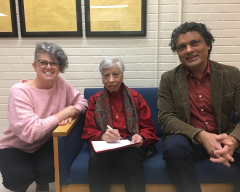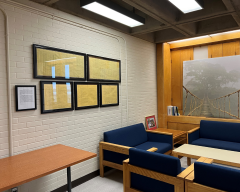Article by Karen Kelly (Faculty of Public Affairs)
The newly dedicated boardroom in Carleton University’s Department of Economics is graced with decor that an economist can truly appreciate. Desk-sized sheets of yellowed graph paper, covered with numbers and symbols, have been framed for posterity.
To the knowledgeable, it is clearly an equation, which took then-PhD student Kanta Marwah two days to create in 1960, when she worked for future Nobel Laureate Lawrence Klein at the University of Pennsylvania.
Her Ph.D. thesis An Econometric Model of Price Behaviour of India was seminal, belonging to the first-generation econometric models of India. It ensured her spot as that university’s first female PhD.
And in 1967, she was hired as Carleton’s first female economics professor and later became the first female full professor in the Department of Economics. She taught students and conducted research for 35 years, publishing in the top tier journals, before her retirement in 2002 when she was named a distinguished research professor and professor emeritus of economics. Since her retirement Dr. Marwah has continued to support Carleton University through the creation of many scholarships and awards for students.
A generous philanthropist, Dr. Marwah recently presented the Department of Economics with a gift of $100,000 to form the Dr. Kanta Marwah Initiatives Fund. It will support faculty and student research activities such as seminars, workshops, special lectures and courses. It is the largest private gift given directly to the department in its history, and in honour of this donation the department’s boardroom will now be called the “Dr. Kanta Marwah Seminar Room.”
“Dr. Marwah has many ‘firsts’ associated with her career which reflect her unique journey, achievements, and contributions to the department for more than 50 years,” says Hashmat Khan, Chair of the Department of Economics. “We have all been touched by her generosity. Her gift will help further enhance our seminar series and support research activities of current and future generations of economists here in the department.”
 |
| Dr. Kanta Marwah (centre) with Faculty of Public Affairs Dean Brenda O’Neill (left) and Department of Economics Chair Hashmat Khan (right) in December 2022.
{Photo by: Karen Kelly, FPA} |
 |
 |
| Kanta Marwah described the worksheets in November 2021 as being OLS computation circa 1960-1961. In her own words:
“The laminated yellow (analysis) worksheets show Ordinary Least Squares (OLS) estimates of an Inventory Investment demand function of the US economy based on 44 quarterly observation for the sample period 1948-1958. It incorporates five explanatory variables plus an intercept. These variables are total sales, inventory stocks at the beginning of the period, change in price level, unfilled orders and short run interest rate. OLS estimates were computed, circa 1960-1961, on desk calculators (Munroe, Friedan), using >Doolittle= solution shown, step by step, in the worksheets. “It took me two days to estimate this equation when the then future Nobel Laureate Professor Lawrence R. Klein hired me as his research assistant right at the beginning of my graduate studies at the University of Pennsylvania. Klein had started building his 34 equations Postwar Quarterly Model and these calculations became a part of trial-testing inventory demand function. (For a discussion of the equation, see A Postwar Quarterly Model: Description and Applications in Models of Income Determination, Studies in Income and Wealth, Vol. 28, ed. Bert Hickman, Princeton University Press, 1964; reprinted in Selected Papers of Lawrence R. Klein: Theoretical Reflections and Econometric Applications, ed. Kanta Marwah, World Scientific, 1997). For the discussion of the full model, as well of a history of computation in econometrics, see A History of Macroeconometric Model-Building by Ronald G. Bodkin, Lawrence R. Klein and Kanta Marwah, Edward Elgar, 1991.)” |